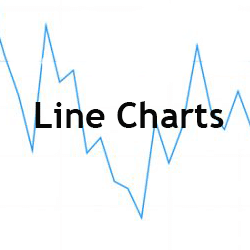
Nowadays, when it comes to trading, technical analysis has become popular with the growing use of personal computers. All traders need to do is opening their trading platforms and using technical analysis tools on different currency pairs and financial markets. However, in the early days of technical analysis, it was not this easy. Developing trend indicators or oscillators was difficult, so, they focussed on trading theories and concepts more.
Table of Contents
Things became easier after pioneers realised that simple strategies are the best one and this concept is valid to this day. Many traders use candlestick charts, a trend indicator and an oscillator with high-frequency trading systems these days, but they are complicated. If you are a beginner and want to keep things simple, then you should go for line charts that once ruled the trading industry along with bar charts.
What is a line chart?
A line chart is a graphical representation that displays the historical price action of an asset. It connects a range of data points with a line. Among all types of charts used in finance, this is the most basic one and it depicts the closing prices of a security over time. This type of chart can be used on any timeframe, but traders mostly use it for day-to-day price changes.
Points to be noted before using line charts
- Using a single and continuous line, the price history of an asset can be visually represented with a line chart.
- Due to its simplicity, traders that want to identify trends or patterns may opt for other types of charts that carry more information, such as candlestick.
- A line chart is simple in form, thus it is easy to understand. It only depicts the changes in the closing price of an asset over time.
A detailed explanation of a line chart
Line charts display closing prices only. So, they reduce noise from lesser critical times in the trading days, such as the open, low, and high. You must know that closing prices are considered the most important generally. This is why line charts are more popular among traders and investors. Traders often combine line charts with other popular chart types including bar charts, point and figure charts, and candlestick charts to see the full technical picture.
Benefits of trading with line charts
Many traders prefer line charts because of its amazing benefits, such as:
- Clarity: While analysing a security’s chart, it is common to get confused with so much information. Known as the trading term “Paralysis by analysis”, this phenomenon represents a condition where charts show plenty of price information and indicators provide multiple signals. Not only it confuses but also leads to complicated trading decisions. So, it is better to use a line chart that assists traders to identify key support and resistance levels, trends and recognisable chart patterns.
- Easy to use: As mentioned before, line charts are very simple, so, they are ideal for traders that are only beginning their career in trading. These charts are perfect for beginners to learn basic chart reading skills before they can learn more advanced techniques like learning the basics of point and figure charts and reading Japanese candlestick patterns. Traders can also apply volume and moving averages to line charts easily.
How to use line charts for trading
According to different situations and purposes to fulfil, you may use line charts in many ways:
Using line charts to find dynamic support and resistance
As mentioned earlier, a great advantage of the line chart is that it can filter the noise in the currency markets. By ignoring the price action between the opening and closing prices and displaying the closing price only, the line chart can reflect the true market nature. Traders can view trends well, and spot turning points easily. Moreover, the classic pattern recognition approach such as support and resistance works best with line charts. To find support and resistance areas, you can use a trendline and connect two points. Then, drag the trendline across the right side of the chart. Lastly, when the price reaches it, the likely outcome would be a rejection or bounce back.
Trading with line charts by focusing on the relevant price action
It is important to consider the fact that the only thing revealed by line charts is the relevant price action. A lot of people consider them too simple to be efficient, but they work best due to this reason. This is how you can trade with a line chart:
- First, set a line chart and then look for dynamic support and resistance in bullish and bearish trends.
- Draw a trendline that connects the previous two lower lows in a bearish market. Drag the line to the right side of the chart.
- Now, you need to place a pending order to sell into resistance or buy into support.
- The stop loss can be set at the top of the candlestick in a bullish trend and the bottom of the candlestick in a bearish trend.
- Finally, you can target a 1:3 risk-reward.
Trading line charts with moving averages
Another way of trading with line charts is by using them with moving averages together. Both novice and pro traders know that moving averages support during rallies and provide resistance in bearing trends. Moreover, according to the rule of thumb, the higher the moving average goes, the price meets the stronger support or resistance. The support and resistance also get stronger with bigger time frames. When you trade with moving averages, keep in mind that they reveal the strength of a trend. When more prices come to the average, the trend becomes weaker and breaks it eventually. Due to this, the rule of thumb implicates to trade the first two times only while the averages are tested by the price. However, the price action is volatile and even chaotic sometimes during the formation of a candlestick. This is why experienced traders use line charts instead of using candlestick charts and consider a relevant test only when the moving average is touched by the line chart.
Final thoughts
Line charts are wonderful tools when it comes to simple technical analysis concepts. Nowadays, traders often get tempted to use various oscillators and trend indicators on a chart due to the use of personal computers, but that does not help always necessarily. Line charts have proven to be more useful even with its simplicity. So, next time when you look for support and resistance, you may consider going for line charts.








Leave a Reply